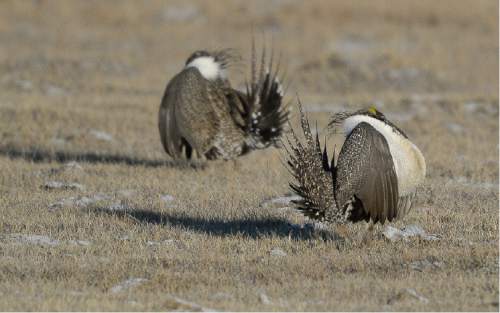This is an archived article that was published on sltrib.com in 2015, and information in the article may be outdated. It is provided only for personal research purposes and may not be reprinted.
Washington • The head of the Interior Department said Tuesday she hopes a pending decision on the greater sage grouse will find it does not need federal protection.
The Fish and Wildlife Service has a court-ordered deadline of Sept. 30 to decide whether the chicken-size bird — which has dwindled in population — should fall under the Endangered Species Act, a protection that several Western states, including Utah, continue to fight.
Sally Jewell, whose department includes the Fish and Wildlife Service, says she hasn't been involved in the process but praised locally driven efforts to find suitable habitat to help revive the bird's population.
"The decision rests with the Fish and Wildlife Service," she said Tuesday at a breakfast hosted by The Christian Science Monitor. "I remain optimistic that a not-warranted listing is possible, but I have stayed completely arm's length from them in terms of that decision."
A congressional act passed last year forbids the Fish and Wildlife Service from actually listing the sage grouse as endangered but the agency is moving forward with its study to see if such a listing is possible.
Western states, including Utah, have paid millions to lobby the government against such a designation, fearing it would harm oil and gas development as well as impact farmers and ranchers.
Jewell said that the determination will come this month and hopes that the outcome will match the "incredible" effort of 11 states, conservation groups, landowners, energy companies and ranchers to help protect the sage grouse. The species once numbered in the millions but is now estimated at 200,000 to 400,000 birds.
Rep. Rob Bishop, R-Utah, chairman of the House Natural Resources Committee, said that listing the sage grouse as endangered is one fear, but there's another worry the federal government will use its power to change land-management plans in Western states to protect the species while dampening development.
"Listing the bird is going through the front door," Bishop said in a statement Tuesday. "Sneaking through the back door would be to have [the Bureau of Land Management] change their management plans to control the land as if the bird were listed."
Bishop said the Interior Department should realize that state management plans are more effective in saving the bird's habitat and there's no need for the "heavy hand of the federal government imposing its will on state, federal and private lands."
The Utah congressman pushed through a provision in a defense spending bill that would prohibit the listing of the sage grouse as endangered for the next 10 years but the measure has yet to face a final vote.









